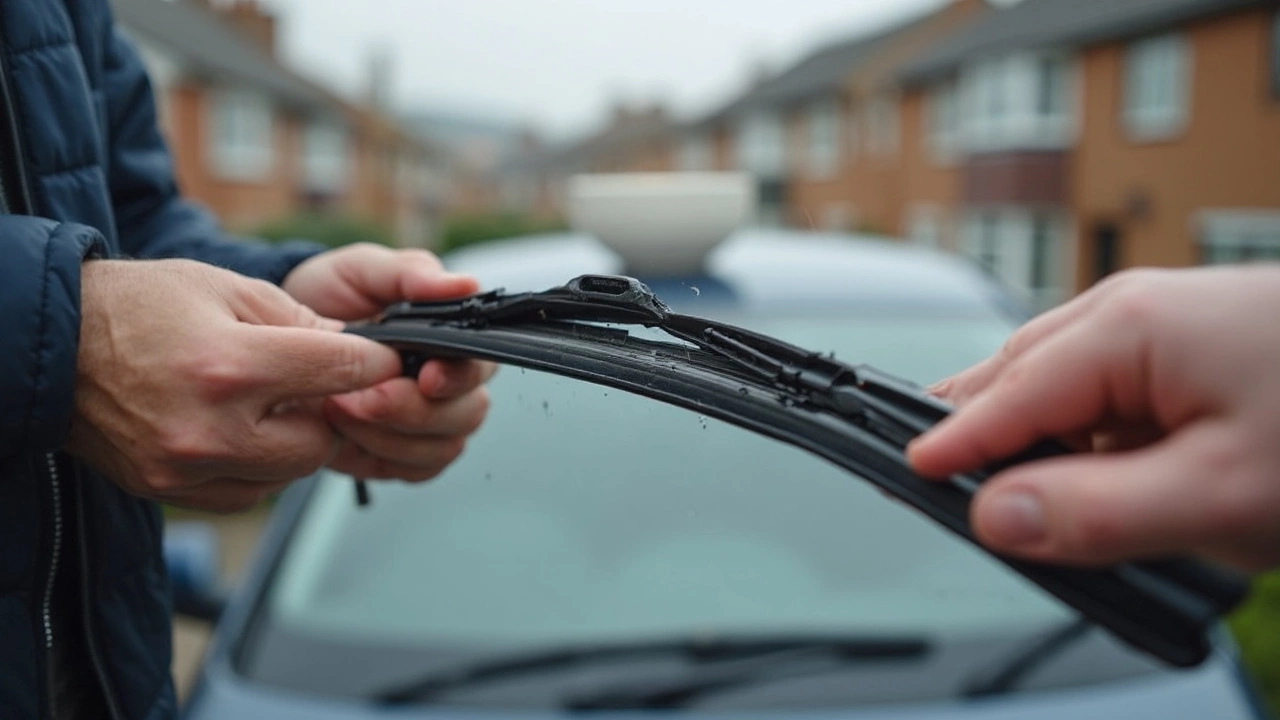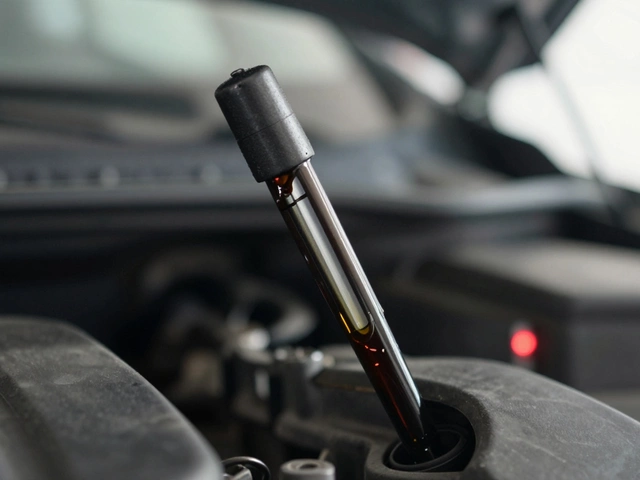Ever had your wiper blades suddenly start skipping or smearing just when a rainstorm hits? It's one of those issues that always seems to pop up at the worst possible time. A lot of people don’t even think about their wiper blades until they’re practically useless, but those simple strips of rubber are your first line of defense when visibility goes south. If you’ve ever driven through a sudden downpour or a foggy morning, you know how fast bad wipers can turn your day into a headache.
The truth is, wiper blades don't last forever. Even if they look fine, they break down slowly from sun, rain, dust, and car washes. Some car owners swap them once a year, others push their luck way longer. So what’s the ideal timeline? More important, how can you tell when yours are done for? There are a few signs most folks miss, but noticing them early saves you money (and frustration) in the long run. Let's break it down, step by step, so you can stay ahead of the game.
- Why Wiper Blades Matter Way More Than You Think
- How Long Wiper Blades Really Last
- The Telltale Signs It's Time to Replace Them
- Biggest Enemies of Your Wiper Blades
- Tips to Stretch Their Lifespan
- Choosing the Right Replacement Blades
Why Wiper Blades Matter Way More Than You Think
Plenty of drivers think of wiper blades as just another boring car part. But they’re actually crucial for keeping you safe. When your windshield isn’t clear, your chances of getting into an accident shoot up. In fact, the U.S. Department of Transportation has linked over 46% of all weather-related car crashes to poor visibility. That boils down to bad wipers more often than you’d expect.
Good wiper blades do more than just swipe away rain—they handle snow, mud, bugs, and any junk tossed up by cars in front of you. If you can’t see the road, you can’t react fast, plain and simple. Newer cars usually come with fancy features, but even the best tech can’t make up for lousy blades.
Check out this quick comparison for how visible your windshield can be, depending on your wiper blades’ condition:
| Blade Condition | Visibility (%) | Reaction Time (seconds) |
|---|---|---|
| New | 100 | 1.9 |
| Slightly worn | 85 | 2.3 |
| Worn out | 60 | 2.8 |
Your reaction time actually gets slower as visibility drops, even if you don’t realize it. Not great when you’re trying to avoid a deer or a sudden lane change. If the wipers can’t clear water quickly, you might as well be driving with your eyes half-closed.
Simply put, ignoring your wiper blades just isn’t worth it. Next time you hop in the car and the weather turns, pay attention to whether your blades are cutting it. It’s an easy fix that has a big impact every single time you drive.
How Long Wiper Blades Really Last
If you’re wondering how long your wiper blades should stick around, here’s the straightforward answer: most brands recommend replacing them every 6 to 12 months. But let’s be real—how long they last depends on what kind of weather you get, how often you use them, and what your car deals with every day.
Live in a sunny state like Arizona or Texas? The rubber breaks down way faster thanks to heat and UV rays. Heavy rain or snow? That constant wiping takes a toll too. Even cold weather makes rubber stiff and easy to crack. If you park outside or drive a lot in cities with air pollution, expect them to wear down faster. Sitting in your garage most days? You might squeeze out a few extra months.
Check out this quick breakdown of what impacts wiper blade life. Notice how much of a difference climate and use make:
| Condition | Average Lifespan |
|---|---|
| Hot/Sunny (Desert) | 4-6 months |
| Cold/Snowy | 6-9 months |
| Rainy/Humid | 6-12 months |
| Garage-kept, mild use | 12+ months |
Car care groups like AAA back this up, saying most drivers should expect to change blades at least once a year, sometimes more. So don’t be surprised if your blades give up sooner, especially if you’re always using the washer fluid or blasting the AC while driving through city grime. And just because your wiper blades look fine at first glance doesn’t mean they’re actually working their best. When in doubt, test them out next time your windshield is dirty or wet—streaks and squeaks mean it’s time for new ones.
The Telltale Signs It's Time to Replace Them
It’s easy to forget about wiper blades until you suddenly can’t see through streaky glass. But don’t wait until things get sketchy—there are some clear signs your wipers are overdue for a swap. If you spot even one of these, it’s time to make a pit stop for new blades.
- wiper blades leave streaks or smears, no matter how wet the windshield is
- Chattering or squeaking noises as they move across the glass
- Blades skip patches or don’t fully contact the windshield
- You notice cracks, splits, or missing pieces of rubber on close inspection
- There’s a haze or persistent film after every wipe, especially at night when headlights make it worse
Stats from auto service shops show most wiper blades start breaking down after 6 to 12 months, even if you don’t use them every day. Intense sunlight, freezing weather, and road salt eat away at the rubber. Some folks in hot climates need replacements more often, while blades up north battle ice and snow.
| Sign | What It Means |
|---|---|
| Streaking & Smearing | Rubber edge is hard, cracked, or warped |
| Chattering Sound | Blade isn’t making smooth contact, possibly twisted or worn |
| Skipping Areas | Loss of flexibility, uneven pressure |
| Visible Damage | Cracks, tears, or missing bits mean the blade can’t work properly |
| Hazy Glass | Blade leaves residue, usually from old, degrading rubber |
Pro tip: Give your wipers a quick clean with a damp rag every couple of weeks. Sometimes dirt or tree sap gets in the way, making blades look bad before their time. If cleaning doesn’t help, new blades are the only way to go. Better safe than squinting through mist on the highway, right?

Biggest Enemies of Your Wiper Blades
Wiper blades seem simple, but a bunch of everyday things work against them. If you’re not paying attention, these little enemies will wear your blades out way faster than you’d expect. Here’s a closer look at what really does them in:
- Sunlight and Heat: Parking outside, especially on hot days, is rough on your blades. UV rays from the sun break down the rubber, making it brittle and weak. If you live in a hot climate, expect to change blades more often.
- Freezing Temperatures: Cold weather doesn't get a pass either. When blades freeze to the glass or scrape over icy windshields, the rubber can crack or tear. People in snowy areas know this pain all too well.
- Dirt and Road Gunk: Dust, sand, pollen, and muddy spray aren’t just annoying—they grind away at your blade’s edge. When debris builds up, your blades don’t just miss spots, they actually get damaged every single swipe.
- Windshield Washer Fluid (or Lack of It): Ever try to run your blades dry? Big mistake. It’s like trying to shave without water. Insufficient washer fluid creates drag and frays the rubber edge quickly.
- Car Washes and Chemicals: Some folks think they’re “protecting” their car, but many car wash soaps and waxes don’t play nice with wiper blades. Harsh chemicals can make the rubber swell, warp, or degrade.
The real trick is knowing that these factors add up. Mix two or three together—like heat, chemicals, and dirt—and suddenly your wipers age in dog years. If you want your wiper blades to last, control what you can: park in the shade, keep your windshield clean, and don’t skimp on washer fluid. It makes a bigger difference than you’d think.
Tips to Stretch Their Lifespan
If you’re tired of buying new wiper blades every few months, it’s time to change up your routine. Keeping your blades in good shape doesn’t take much effort, and a few easy habits really pay off. Here’s what helps the most:
- Keep your windshield clean. Dirt and grit act like sandpaper on the rubber every time you use your wipers. A quick wipe with a damp cloth or during a fuel stop is all it takes.
- Don’t use your wipers on a dry windshield. When there’s no water or washer fluid, dry friction wears the edges down fast.
- Use the right washer fluid. Some folks use plain water, especially in summer, but that can cause mineral build-up and damage. Go for proper windshield washer fluid, especially if you live in a place with freezing winters.
- Park in the shade or use a windshield sun shade. UV rays are rough on rubber, making it crack and break down way quicker. Blades left baking under summer sun turn brittle in months.
- Lift your blades in snow or ice. If they freeze to the glass, they can tear as soon as you turn them on. Some people keep a small bottle of de-icer in the trunk for nasty mornings.
Here’s a quick cheat sheet for things that kill wiper blades fast versus habits that keep them going longer:
| Bad for Blades | Good for Blades |
|---|---|
| Hot sun all day | Shade or windshield cover |
| Dry wiping (no fluid) | Plenty of washer fluid |
| Leaving ice on glass | Lifting blades in snow |
| Ignoring dirt and grit | Wiping windshield often |
Also, try cleaning your wiper blades themselves every couple of weeks. Just run a clean, damp rag down the rubber. It takes 30 seconds and means clearer views and fewer replacements. Studies by the AAA have shown people who do this see about 20% longer blade life. Not bad for something you can do while pumping gas.
Choosing the Right Replacement Blades
Picking the best wiper blades isn’t as simple as grabbing whatever’s on sale at the auto store. The right fit and style can make a night-and-day difference when it comes to clear vision during bad weather. If you’re just sticking with what came on your car, you might be missing out on big improvements in durability and cleaning power.
First off, check your car’s manual or measure your old blades to get the exact size. Most cars need different lengths for the driver and passenger sides—mixing up sizes is easy, but it won’t wipe your windshield properly. If you want to save hassle, buy a pack labeled specifically for your car’s make, model, and year.
There are a few main types of blades:
- Traditional frame-style blades: These are the most common, and usually the cheapest. They have a metal framework holding down the rubber strip. They’re reliable, but don’t always hug the windshield during hard rain or snow.
- Beam blades: These feature a one-piece, flexible design that applies even pressure all the way across the glass. They work great in tough weather, especially snow and ice, and last longer than frame styles. Lots of newer cars use these.
- Hybrid blades: As the name suggests, they combine parts of both designs—usually a frame covered in a protective shell. They’re tough, a little pricier, but really good if your climate changes a lot.
It’s tempting to go cheap, but premium blades actually last longer and clear better. Some high-end options can go up to a year or more, while cheaper ones may need changing in just six months if you drive a lot. If you’re confused by brands, stick with names like Bosch, Rain-X, or Valeo—they tend to hold their own in tests.
| Type | Average Lifespan | Price Range (USD) |
|---|---|---|
| Frame-Style | 6 - 9 months | $8 - $18 per blade |
| Beam Blade | 9 - 15 months | $18 - $30 per blade |
| Hybrid Blade | 12 - 18 months | $15 - $30 per blade |
If you use your car in harsh weather, consider wiping performance in snow and ice as much as rain. If you notice chattering, streaking, or noisy action soon after installing new blades, double-check that they’re snapped in right and the arms aren’t bent. For the best wiper blades, match the size, type, and brand to your car’s needs, not just your wallet. Finally, don’t forget the rear wiper if you drive an SUV or hatchback—it’s easy to overlook, but just as important for seeing what’s behind you.


